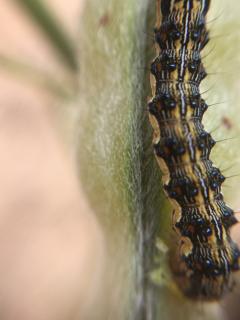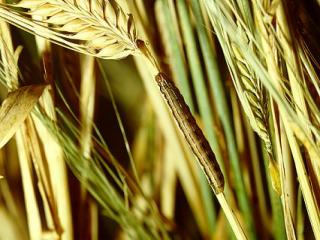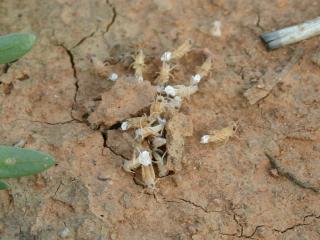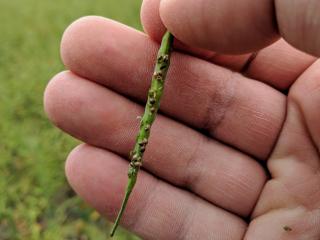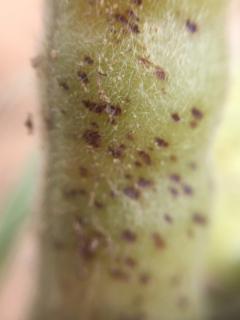Native budworm are being managed in canola and pulse crops further south
- Moorine Rock
- Kulin
- Nyabing
- Mobrup
- Katanning
Biosecurity officer Cameron Wild (DPIRD) reports finding native budworm caterpillars in a lupin crop near Moorine Rock. The crop was at the pod ripening stage.
An agronomist has found up to nine budworm caterpillars per 10 sweeps in a pod ripening lupin crop at Kulin this week.
An agronomist has reported finding between 10-40 budworms in 10 sweeps in canola crops at Nyabing, Mobrup and west Katanning.
Native budworm caterpillar activity across WA is still being tweeted by growers and consultants.
DPIRD’s native budworm moth trapping program has finished for the season but trapping results are available at the department’s Native budworm moth numbers 2018 and cesar’s MothTrapVisWA page.
All late maturing pulse and oilseed crops should be checked for native budworm.
Farmers with native budworm caterpillars in their crops need to be mindful of insecticide withholding periods (WHP) close to harvest and remember that windrowing is classified as harvest.
For more information on native budworm control refer to DPIRD’s Management and economic thresholds for native budworm page.
For more information contact Dustin Severtson, Development Officer, South Perth on +61 (0)8 9368 3249 or Svetlana Micic, Research Officer, Albany on +61 (0)8 9892.
Armyworm can be a threat to cereal crops
- Wubin
- Wittenoom Hills
Nick McKenna (Planfarm) reports finding low numbers (less than one per 10 sweeps) of armyworm caterpillars in an Impress CL Plus wheat crop near Wubin. The crop was at dough development.
Plant pathologist Andrea Hills (DPIRD) has found less than one armyworm per 10 sweeps in a Scepter wheat crop near Wittenoom Hills. The caterpillars could be seen feeding on the leaves.
It is that time of year again, when cereal crops are ripening and armyworm caterpillars may live up to their name, by damaging cereal crops in a wave like an army front. Growers are advised to check their cereal crops at this time as substantial areas of damaged crop are often not noticed until harvest time. This can be prevented by monitoring crops with a sweep net and visual inspection of caterpillars and plant damage.
Technical officer Amber Balfour-Cunningham (DPIRD) has found caterpillars up on barley heads in her barley trial site at Northam. Initially it was assumed these were armyworm but close inspection showed they were native budworm which must have come from nearby peas or weeds which had dried out. Unlike armyworm, native budworm are not known to feed on cereals unless forced onto them through the death of their preferred hosts such as canola and pulses. Another species however, called the lesser budworm, does feed on cereal plants and occasionally is detected and causes crop damage.
Managing armyworm in cereals
When there are sufficient numbers armyworm are known to cause the most economic damage to barley crops when the plants are starting to hay off and they chew or lop the heads off. Damage to wheat and oat crops occurs less frequently and is usually minor compared to damage in barley. Armyworms are seldom a serious problem in pastures.
Assessing the numbers of armyworm in a cereal crop can be difficult, as their movements will vary with weather conditions and feeding preference. Sometimes they are found sheltering on the ground and under leaf litter whilst on other days they will be high up on the plants or on the heads and easily picked up using sweep nets. This is important to note if sweep netting cereal crops. Larger caterpillars often prefer to hide during the day and feed at night.
The threshold for spraying armyworm in mature barley is about three large armyworm grubs per square metre of crop. The threshold for wheat or oats is much higher as only grains are consumed and heads are very rarely dropped. Spray thresholds in these crops are more like 10 grubs per square metre of crop.
A number of effective insecticides are registered for the control of armyworm if required (see the department’s Winter/Spring Insecticide Spray Chart 2018). Spraying late in the afternoon or evening is recommended as armyworms are predominately night feeders.
For more information refer to the department’s Diagnosing armyworm and Management of armyworm in cereal crops pages.
For more information contact Dustin Severtson, Development Officer, South Perth.
Australian plague locusts are hatching
- Wilgoyne area
Steve Palm has reported that Australian plague locusts (APL) are hatching in the Wilgoyne area.
Surveys conducted in autumn by DPIRD staff indicated that very low densities of APL hatchings were expected this spring in the central agricultural region. However, if you observed locust activity on your property in autumn monitor for locust hatchings.
Control of the locusts can often be more effective if clusters of the newly hatched tiny nymphs can be identified and spot sprayed before they spread out. The locusts hatch from eggs as wingless nymphs that are about 2mm long. The nymphs develop through five stages, increasing in size at each stage. The final moult to the winged adult usually takes 6-8 weeks. Developing nymphs need green plant material to survive. If there is abundant green material during late October, it is expected that the developing nymphs will have lower mortalities.
When APL are about 1cm in length or third instar (about 3-4 weeks after hatching) they tend to congregate and form bands. This is the stage at which they are most effectively controlled with insecticides.
Insecticide sprays have better efficacy if applied early in the morning of a day that will be warm. APL adults are more likely to come into direct contact with the spray as they do not move quickly when it is cool. As the day warms up, adults will move onto sprayed vegetation and are more likely to ingest sprayed vegetation. For insecticide information refer to the department’s Australian plague locust control: registered insecticides.
Use the department’s free PestFax Reporter app to report locust activity in spring, and to assist with mapping locust movements, or contact the Pest and Disease Information Service (PaDIS) on 1800 084 881.
Further information on identification, monitoring and control for locusts is available at the department’s Diagnosing locusts and grasshoppers in crops and Australian plague locust:overview pages.
For more information on locusts contact Svetlana Micic, Research Officer, Albany on +61 (0)8 9892.
Canola aphid update
- Woodanilling
Entomologist Dusty Severtson (DPIRD) has inspected a canola crop west of Woodanilling and found that almost all of the green peach aphids (GPA) on the stems and pods had been parasitised by tiny wasps and most of what remained were the empty 'mummy' shells where the wasps had emerged. The crop will not require spraying. He noted that many canola crops are rapidly turning and colour changes to the pods indicate that the pod tissue is quickly becoming unfavourable for the aphids which remain in the crops.
For more information on GPA in advanced canola crops, see last week’s PestFax Issue 27 article Green peach aphids are causing some concern in advanced canola crops.
For more information on identifying and managing canola aphids refer to DPIRD’s;
- Aphid management in canola crops page
- Diagnosing canola aphids page
- 2017 Protecting WA Crops Issue 3 newsletter Aphids – WA’s insect problem children
- Aphids in your crops YouTube video.
For more information on contact Dustin Severtson, Development Officer, South Perth on +61 (0)8 9368 3249 or Svetlana Micic, Research Officer, Albany on +61 (0)8 9892.
Brown spot in lupins
- Mingenew
- Moorine Rock
Crop protection officer Bonnie Jupp (DPIRD) has found what is suspected to be brown spot in lupins near Mingenew. The crop was at the pod ripening stage.
Biosecurity officer Cameron Wild (DPIRD) reports finding brown spot in lupins at the pod ripening stage near Moorine Rock.
Brown spot (Pleiochaeta setosa) spores are present in soils where lupins have been grown previously. Lupin leaves infected with brown spot drop to the ground and spores are produced on the dead tissue. These spores become incorporated into the surface layers of the soil and remain dormant there. Spores can persist in the soil for several years through non-lupin rotations, although their population reduces over time.
Spores are splashed by rain from the soil surface onto leaves of lupin plants resulting in the appearance of dark brown lesions which can distort leaves and result in premature defoliation. Oldest leaves are affected first. Newly emerged seedlings and young plants are at greatest risk of brown spot infection. Brown spot can occasionally develop in the mid-upper canopy of lupin crops following heavy rainfall. Pods, particularly those set closer to the ground, may be flecked or develop larger brown lesions.
The same fungus causes both brown leaf spot and Pleiochaeta root rot in lupins. Disturbance of the soil through cultivation and sowing can incorporate the spores into the root zone resulting in a higher risk of Pleiochaeta root rot for the next lupin crop.
Plant pathologist Geoff Thomas (DPIRD) says that the impact of brown spot can be reduced through rotation of crops, the use of seed dressings and through measures which reduce spore splash such as retention of cereal stubble. Foliar sprays are ineffective and no products are registered.
As lupin rotations have widened and with greater levels of cereal stubble retention reducing soil splash, severe brown spot is less common, although lupin crops will often have low levels of disease symptoms on lower older leaves.
For more information refer to the department’s Diagnosing brown spot in narrow-leafed lupins.
For more information contact Geoff Thomas, Plant Pathologist, South Perth on +61 (0)8 9368 3262.
PREDICTA® B Root disease risk management course is coming to Perth
- Date: Monday 10 December 2018
- Time: The course will begin at 8.30am and finish around 3.30pm
- Venue: Perth Technology Park, Seminar Room 3, 2 Brodie Hall Drive, Bentley WA
- Fee: $423.50 (including GST). This covers catering, a hard copy of the soilborne disease manual plus all participants receive a soil sampler.
New and experienced agronomists are invited to attend the PREDICTA® B Root Disease Risk Management course to build or refresh their skills and knowledge on soilborne diseases.
The one day course also provides accreditation for delivering PREDICTA® B – the DNA-based soil testing service which enables growers to identify the pathogens posing greatest risk to their farm.
This course is also being conducted at Adelaide, Ballarat, Echuca and Parkes in November.
The course will cover:
- The main soilborne diseases for the region including rhizoctonia, crown rot and root lesion nematodes
- Interpreting and understanding PREDICTA® B results
- Using PREDICTA® B to make better informed variety, rotation and paddock management decisions
- Yield loss risk categories for established tests and population density categories for new tests
- Management options
- Soil borne diseases in dry times – what you need to know
- Soil sampling strategies.
On completion, agronomists will receive:
- An accreditation number to access the PREDICTA® B service
- The Broadacre Soilborne Disease Manual, updates can be downloaded from website
- A PREDICTA® B soil corer suitable to your region.
For more information and to register for the Perth course visit the AgCommunicator’s PREDICTA® B: 2018 Root Disease Risk Management Course - PERTH page.
For more information contact Loren Revell-Kartuz, Event consultant at AgCommunicators, on +61 (0)8 8332 3277.

